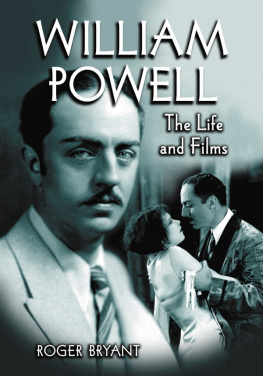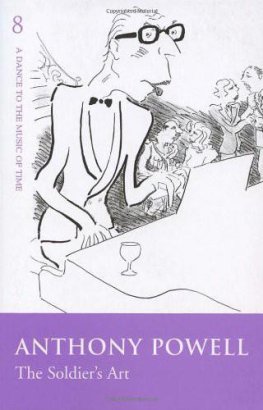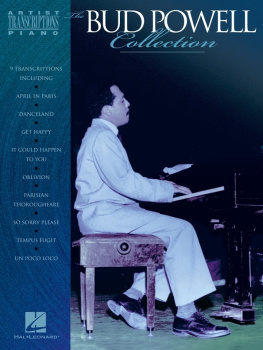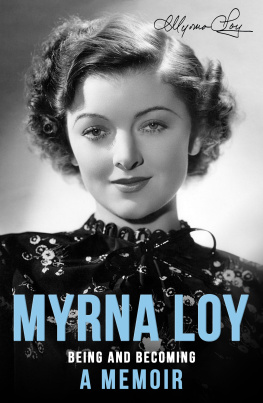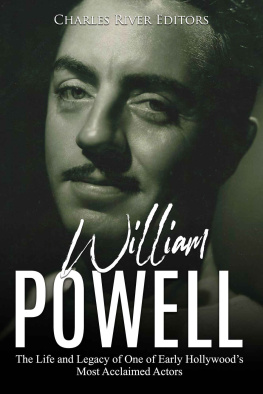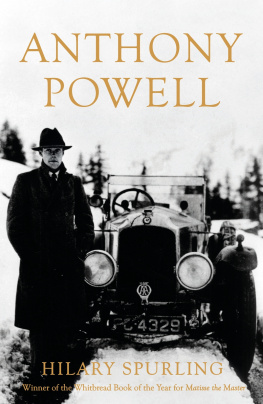
Table of Contents
LIBRARY OF CONGRESS CATALOGUING-IN-PUBLICATION DATA
Bryant, Roger, 1961
William Powell : the life and films / Roger Bryant.
p. cm.
Filmography : p.
Includes bibliographical references and index.
ISBN-13: 978-0-7864-2602-7
1. Powell, William, 18921984. I. Title.
PN2287.P58B79 2006
791.4302'80924dc22 2006020496
[B]
British Library cataloguing data are available
2006 Roger Bryant. All rights reserved
No part of this book may be reproduced or transmitted in any form or by any means, electronic or mechanical, including photocopying or recording, or by any information storage and retrieval system, without permission in writing from the publisher.
On the cover: Portrait of William Powell c. 1926-1927; (detail) Powell and Clara Bow in The Runaway, 1926 (both courtesy Christian Anderson Collection)
McFarland & Company, Inc., Publishers
Box 611, Jefferson, North Carolina 28640
www.mcfarlandpub.com
For Deanna,
as perfect for me as
Nora was for Nick
Acknowledgments
A project of this size requires an enormous amount of assistance. To anyone I neglected to mention, I offer my apologies in advance.
Ned Comstock at the University of Southern California Cinema-Television Library was the first librarian I contacted, and he was a great help and encouragement.
Ned generously pointed me to others who also could help with this project. Among these were Barbara Hall and her staff in Special Collections at the Margaret Herrick Library of the Academy of Motion Picture Arts and Sciences; Mark Quigley and his staff at the UCLA Film & Television Archive; and Haden Guest and the staff of the Warner Bros. Archive at USC.
I also want to thank Sally and Jerri at the Palm Springs Historical Society, and the staff of the Browne Popular Culture Library at Bowling Green State University.
Also of continuing assistance was the staff at Grace A. Dow Memorial Library in my hometown.
Christian Anderson graciously supplied photos from her amazing William Powell collection, and offered ongoing support and assistance, as well as insights into Powells life and films. As far as I can determine, she is the William Powell collector par excellence.
Garrett Willette made a major contribution with his computer photo skills.
I owe a large debt of gratitude to my colleagues at Allis Information Managementtheir patience, their support, their encouragement, their laughter, their friendship and their confidence in a very real sense helped make this book possible.
I also want to thank my church family at Midland Evangelical Free Church. The prayers of many brothers and sisters propelled me forward when I most needed them.
My parents, Jeff and Betty Bryant, my brother and sister-in-law, Tom and Jerri Bryant, my wifes parents, Ken and Delora Burris, and my sister-in-law and her family, Joy, Scott, Jonathan and Jesse Eshlemanthank you for asking how it was going, for telling me I could do it, and for rejoicing when it was done.
To my friends Shawn Ritenour, Bill Johnson, Kevin Kasper, Perry LaHaie, Joe Schariter, Jeff Salbato and Abel Kimmthank you. You are princes among men. Your friendship is precious to me.
Finally, to my wife Deanna: You encouraged me to begin, then enabled me to continue, then cheered me to finish. No one ever had a better wife, or a better friend.
Introduction
William Powell died more than 20 years ago, and he made his last film more than 50 years ago. But thanks to cable television, videotape, DVD and the Internet, his films are more accessible now than they were at the time of his death. His first movie was recently restored by a major film archive, and all three of his Academy Awardnominated performances are available on DVD. And his most popular series of films, when released as a DVD set in summer 2005, shot immediately to the top of the Amazon.com DVD best-seller listnot just in the Classics category, but among all DVDs.
Why the interest in an actor whose last film was released in 1955?
The paradox of Powells continuing appeal is that while he was one of the most elegant actors ever to grace the screen, he was almost always authentic and accessible. His characters often display courtliness and good manners, usually leavened with irreverent wit. His evident intelligence, his dignity and even his suave demeanor rarely make him remote. His face, his voice and his eyes communicate genuine emotion and bring a rare humanity to nearly every role.
This combination of elegance and accessibility informs a body of work that is remarkable in its range. A glance at just two of his best-known rolesNick Charles in the Thin Man films and Clarence Day in Life with Fatherdemonstrates that he was far more than a movie star who always played the same part. But though very different from each other, both Nick and Father Day are recognizably human beings and not mere dramatic constructs.
This book aims to examine the films of William Powell and, to a lesser degree, his life. It has been 20 years since the last biography of the man, and that book focused to a large extent on his personal life.
To be sure, it was a life at least as dramatic as many of his filmsthe tragic death of his fiancee, then one of Hollywoods biggest stars; a diagnosis of cancer and his bold decision to undergo experimental treatment when few survived the disease; the happiness he finally found in marriage, to a woman many years his junior; the suicide of his only child; his relatively early and permanent retirement from the public eye.
While this book will touch on those events, the primary focus is on his workmore than 90 films produced from the heyday of the silent era to the age of CinemaScope. Comment is provided on most of his films currently available for review, including many of his lesser-known movies from the 1920s and early 1930s.
There are unavoidable gaps. Sadly, no prints are known to exist of nearly 20 of Powells silent filmsa situation all too familiar to movie lovers. Often through neglect or carelessness, and sometimes through short-sighted, intentional destruction, a majority of all silent films are believed to be lost.
There is good news: Powells first film, Sherlock Holmes (1922), was recently restored by the George Eastman House, one of the worlds top film archives. Videotape copies of Powell silent films including Romola (1924), Feel My Pulse (1928) and the Oscar-winning The Last Command (1928) have been in circulation for several years.
Even better news for Powell fans is the frequent showing of most of his post1930 films on cable television, and the increasing availability of his films on DVD.
My interest in William Powells films began in college in the early 1980s. Movies were a frequent topic of discussion in the dorm, and one friend mentioned how much he enjoyed Powell, especially in The Thin Man and Mister Roberts. When I tracked down those films, I was hooked. Although I wasnt sure why at the time, I found the man not only funny, but great company.
Todays movie lovers dont have to wait for a late-night TV showing or a film festival to encounter William Powell. This book describes the great, the good and the not-so-good among his films. May it help introduce new generations to his timeless style, wit, intelligence and humanity.
1. Hello, Sugar!
From the moment Nick Charles greeted wife Nora with Hello, Sugar! in their first on-screen meeting, the sleuthing couple captivated moviegoers. When Nick is first seen in the film adaptation of Dashiell Hammetts best-selling novel
Next page
